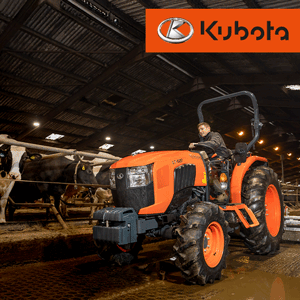In this article, we’ll break down five key factors that are driving tractor prices up, from cutting-edge technology to supply chain challenges.
1. Advanced technology and precision farming
Modern tractors are no longer just machines for pulling ploughs and trailers – they’re highly sophisticated, computer-controlled tools. Modern models can come equipped with:
- GPS and autosteer systems
- Isobus compatibility
- Telematics and remote diagnostics.
2. Increasing material costs
The cost of many of the raw materials used in tractor production have risen sharply in recent years. Tractors require:
- High-strength steel for frames and engine components
- Large, durable tyres designed to handle rough terrain and heavy loads
- Complex hydraulic and electronic systems to power implements and automation.
Fluctuations in global metal and fuel prices directly impact tractor manufacturing costs, which are passed on to buyers.
3. R&D costs
Tractor manufacturers invest heavily in developing fuel-efficient, emission-compliant, and high-performance machines. The move towards alternative fuels and electric tractors means even more R&D costs – which further drives up prices for consumers.
Additionally, manufacturers must comply with strict emissions regulations.

4. Manufacturing and supply chain challenges
Building a tractor involves hundreds of components that are sourced from multiple countries. Disruptions in global supply chains – such as recent semiconductor shortages – have led to increased costs and production delays.
Labour shortages and rising wages in manufacturing also contribute to price increases.
5. Brand reputation and dealer support
Premium brands of tractors charge higher prices, in part, due to their reputation for reliability, dealer networks, and resale value. Farmers will often pay more for:
- Strong warranties and after-sales support
- Ready access to genuine parts and servicing
- Improved resale value to compared to less established brands.
Unlike the automotive industry, the agricultural machinery market is dominated by a small number of major players. With limited competition, and high demand, prices are inevitably driven higher.
Modern tractors are far more than simple farm vehicles. The cost of advanced technology, rising raw material prices, supply chain challenges and limited market competition all contribute to rising prices.
Whilst costly, investing in a modern tractor can improve efficiency, reduce long-term running costs, and boot farm productivity and profitability. However, second-hand tractors remain a strong alternative for many farmers looking to cut costs.
Read: Claas announces wider tractor range and precision farming upgrades
In this article, we’ll break down the science behind tractor tyre size and how it benefits farmers in the field.
Spreading the load
Soil compaction is a major concern for farmers. When heavy machinery presses down on the ground, soil is compressed, reducing aeration and drainage making it harder for crops to grow.
Large tyres help prevent this by spreading the weight over a larger surface area. This reduces the pressure per square inch on the soil, minimising compaction and preserving soil health.
Tractor traction
Farmers are often working on muddy, uneven, or soft terrain. Large tyres increase the contact area with the ground, improving grip and reducing the chance of tractors getting stuck.
This is especially important for:
- Ploughing – where deep soil contact is needed
- Towing heavy loads – ensuring the tractor can pull trailers, balers, or sprayers without slipping
- Working on slopes – providing stability on uneven ground.
The deep treads on tractor tyres are also cleverly designed to self-clean, preventing mud from clogging the tyre and reducing traction.
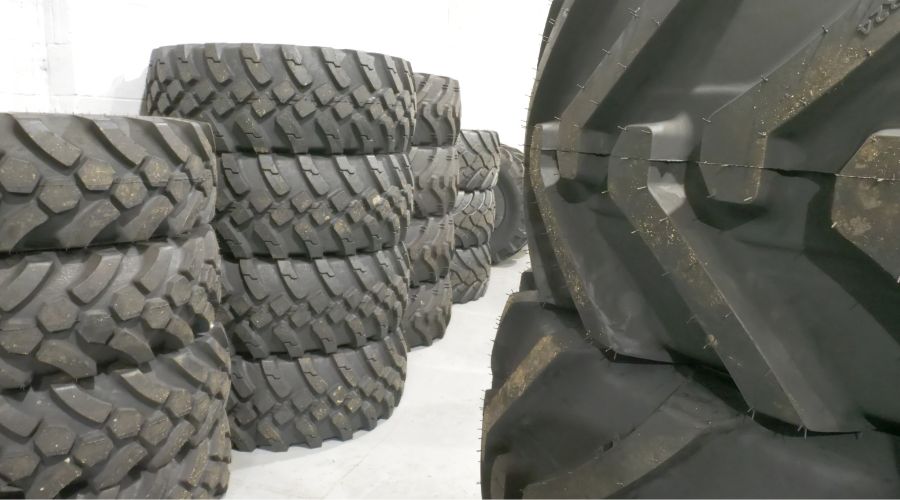
Increased stability
Tractors generally have a high centre of gravity, potentially even more so when carrying heavy equipment.
Large wide tyres that are spaced far apart help provide a wider base, improving stability and reducing the risk of tipping – especially on hilly, or uneven terrain. This plays a crucial role in farm safety, as tractor rollovers are a leading cause of farm accidents.
Reduced fuel consumption
Bigger tractor tyres reduce the amount of rolling resistance, meaning tractors require less power to move across fields. This improves fuel efficiency and reduces operating costs over time.
A narrower tyre would sink deeper into soft ground, increasing resistance and forcing the engine to work harder. Wider tyres are able to “float” on the surface, requiring less effort to move.
Radial vs bias-ply
There are two main types of tractor tyre:
- Radial tyres – more flexible, offering better fuel efficiency and lower soil compaction
- Bias-ply tyres – more rigid, offering stronger sidewall support for heavy loads.
Radial tyres are now preferred for most farm applications because they allow for larger surface contact without excessive weight, improving performance. However, bias-ply tyres still find utility as a cheaper alternative.
To conclude, tractor tyres are big for good reason – they protect the soil, improve traction, enhance stability, reduce fuel costs, and handle heavy machinery effectively.
While they may look oversized compared to regular vehicle tyres, their design is essential for modern agriculture.
Ascenso helps farmers choose best tyres.
In short, the answer is no. This is explicitly stated in the Highway Code, and is covered by the Road Traffic Act 1988. Motorways are specifically designated for “fast-moving” traffic, and tractors, with their lower speed limits and wider designs, pose a potential safety risk to other motorway users.
Certain other slow-moving vehicles, such as mobility scooters and bicycles, are also banned from motorways for similar reasons. The general rule is that if a vehicle cannot maintain a constant speed of at least 50mph, it should not be on a motorway.
Why tractors are banned from the motorway
- Speed and traffic flow – Most tractors have a top speed limit of between 20-40mph, well below motorway speed limits. This would cause major disruptions to fast-moving traffic.
- Safety concerns – Motorways are designed for road vehicles that can accelerate and decelerate rapidly; therefore, slow-moving tractors present a hazard, particularly when merging or crossing slip roads.
- Vehicle suitability – Tractors are designed for rough terrain, meaning they may not handle motorway conditions well. Additionally, some tractors lack the necessary lighting, mirrors and indicators required for safe motorway use.
Alternative solutions for moving tractors
If a tractor or large piece of machinery does need to be transported over a long distance, there are several legal and practical alternatives:
- Low loaders and transporters – a commonly adopted method is loading tractors onto a flatbed or low-loader trailer.
- A-road routes – while slower, sticking to A-roads and major B-roads ensures legality and minimises disruption.
- Farm-to-farm coordination – some farmers coordinate with others to help reduce unnecessary long-distance travel.
In summary, while the idea of taking a tractor on the motorway might seem like a tempting shortcut, it is illegal and unsafe. Farmers and contractors should plan routes accordingly, ensuring compliance with UK road laws and prioritising safety for themselves and other road users.
Unveiled at the Agritechnica exhibition in Hanover, which took place in 2023, the TSB (trailing shoe boom) range allows precise application of organic fertiliser and enhances nutrient utilisation in the soil.
The new TSB2 model is now available in 15–18–21m versions. The TSB2 version includes two vertical distributors and six versions for working widths of 15m, 15–18m, 18m, 18–21m, 18–21–24m, and the newly added 15–18–21m.
Samson Agro says that the TSB has been designed to meet the demands of contractors and large-scale farms, offering the adaptability needed for the most challenging agricultural tasks. The working widths ensure excellent distribution and even lateral application of fertiliser under various conditions and on all soil types.
The Active Contour System is available as an option, allowing the boom wings to adapt freely to the contours of the field. With its three modular sections and floating mechanism, the TSB2 maintains consistent contact of the shoes with the soil, thereby minimising nutrient loss through evaporation and ensuring uniform application across the entire working width. The boom’s design allows for easy integration with all tankers, whether new or already in service.
Thanks to a modular design, users can adjust the working width according to their specific needs. The slide system allows for quick and effortless adjustment of the working width. Meanwhile, the Samson Active Pressure Management feature allows the adjustment of shoe pressure on the soil to preserve plant quality and achieve better results.
The TSB2 model also offers the option to activate the right or left side of the boom, thus eliminating overlap zones and reducing the risk of over-application. The SlurryMaster 5000 or 8000 control terminals automatically adjust the slurry flow to the newly selected working width.
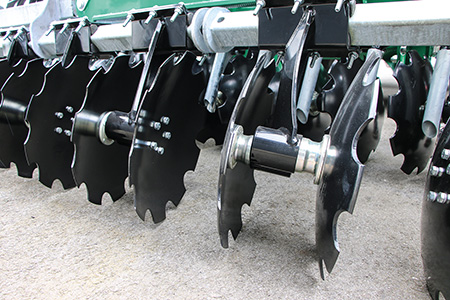
Samson has also launched two new disc incorporators, the CDf and CDx. These innovative tools combine high-performance fertilisation and soil preservation, optimising the use of organic fertilisers even near residential areas, while preparing the seedbed in various agricultural environments, Samson reckons.
They are designed to adapt to different soil types. The CDf is ideal for light post-harvest work and stubble and cover crops, with a working depth of 3–12cm and a width of 4.5–6m.
Meanwhile, the CDx, designed for heavier soils, offers a working width of 8m and an adjustable depth of 3–12cm. The range now includes five models: CDf, CDx, CM, SD II, and Strip-Till.
Visit Samson Agro online for more information
View FarmAds muck and slurry equipment for sale
AgriSpread offers a large range of AS Series mechanical land drive and hydraulic drive Isobus twin-disc spreader models options, capable of spreading fertiliser to 36m and lime/basalt/bulk flowable products up to 12–16m.
The company says its versatile fertiliser and lime spreaders are a perfect fit and well suited to the UK’s farming conditions with large flotation wheels, stainless steel key components and a full stainless-steel hopper, robustly built for stability in lime/basalt spreading and bulk products with small, medium and large capacity models available in single and tandem axle.
They are available in 16 model versions with a large choice of hopper capacities in two ranges:
- AS 2000 Series: Eight models (6–16.8m3), hydraulic drive Isobus versions only
- AS 1000–2K Series: Eight models (2.6–13.9m3), ground drive and hydraulic drive Isobus options.
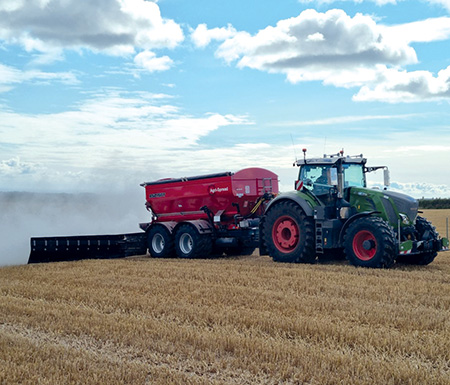
The AS Series spreaders incorporate high specification features with or without advanced precision technologies along with functional design to deliver the target rate to reduce input costs and improve crop response and growth.
All models feature hydraulically driven spinner disks (no PTO) that give optimal control of the spinner disk speeds for normal spreading, boundary spreading and various section control spreading in single or twin floor belt options.
With Isobus dynamic automatic rate control, the product flow is constantly measured and automatically adjusted to maintain a precise application rate per hectare. Variable rate application is compatible with precision farming prescription maps and available as standard on all Isobus hydraulic drive models.
Load weight cells are mounted on a double chassis design which ensures they are shock-proofed and available in ‘read only’ and full ‘Isobus auto rate control’ versions.
Machines are available in the UK via distributor Dales Agri Sales Agency, which says it is fully committed to supporting farmers and contractors across the country.
View FarmAds spreaders for sale
It’s designed to achieve the maximum efficiency from your soil by lifting and shattering compaction, allowing air, water and nutrients to flow into the substructure, improving soil health and preventing flash run-off of water.
The row of leading discs can all be adjusted with one handle, which has six working positions and one out-of-work position.
The discs can be kept in their optimum working position, cutting through the sward cleanly, allowing the leg to pass through without tearing the surface.
Each of the contoured, low-draft legs are mounted in-line on the substantial frame, with two M16 shear bolts for protection.
The flat, rear roller has simple dual turn-buckle adjustment to control the working depth of the machine, and leaves a neat, level finish across the width of the work.
There is an adjustable scraper mounted within the roller arms to prevent congestion and build-up. The legs, knock on points and all other wearing components are widely available, which reduces cost and downtime.
The Sub-Line is available from a single leg machine up to a five-leg machine. All sizes are compatible with Category 2 linkage, from 40–190hp.
Visit the Ceres Machinery website for more information.
View FarmAds grassland machinery and equipment for sale
Designed to enhance safety and productivity, Gardloc offers robust and reliable power take-off (PTO) protection.
These complete PTO shafts are fully approved and certified to EN 12965:2019, ISO 12100:2010, and ISO 5674:2009 quality standards, ensuring exemplary safety and reliability for Fleming customers, the company says.
Gardloc not only enhances PTO safety but saves valuable time and effort. Thanks to the unique A lock technology, users can secure the PTO guard with a single action, making it one of the easiest to secure on the market.
By reducing the complexity and time required for maintenance, users can focus more on their essential tasks, boosting overall productivity, Fleming adds.
Fleming purchasing manager Graeme Parke comments: “We have had positive feedback from our customers with the Gardloc PTO Shaft. Gardloc is an innovative product that helps farmers maintain PTO Shafts and keep them safe – that’s why Flemings have decided to invest in this technology.”
Visit the Fleming website for more information
View FarmAds trailers for sale
Suitable for a car or truck trailer, the new Powerlift Separator can be built (capacities between 25m³/hour and 150m³/hour), to suit a specific application(s).
The entire mobile set-up, including feed-pump, macerator, liquid-phase pump, control technology, as well as the Separator, is all designed and manufactured in one, compact unit by Börger.
The Powerlift can be extended hydraulically to a discharge height of more than 4.3m, so that even large dump trucks can be filled easily.
The Börger rotary lobe pump (benefitting from Maintenance-in-place) feeds the BioSelect, and at the same time sucks the medium to be separated through the macerator (a Börger Multi-Chopper), which then shreds the fibres, depositing impurities into the debris collector.
Achieving dry solids (DS) content up to 38%, the Börger Separator is load-triggered, whilst the feed pump ensures that volumes do not exceed capacity.
The high-density solids-discharge-pump determines the degree of thickness, so the user can (for example) thicken 4% dissolved solids (DS) content liquid into 12% DS, to make it suitable for a tanker.
Likewise, liquid manure and fermentation residue can be thickened to 22% DS, without making any mechanical adjustments to the machine.
View FarmAds muck and slurry equipment for sale
There have been some updates to the Tempest range of reelers, including a fully incorporated bash bar and lighting unit, along with some driveline updates to match the Scorpion drop in bobbin reeler.
Wox says it is seeing requirements for increased power and speed of deployment of lay flat pipe. With weather windows tightening, speed and unmatched performance is required to keep outputs of drag hose systems applying the liquid gold at the right time and place, to the maximum.
With the continued development of the range of pumping stations from Wox Agri Services, the choice of engine driven units is now firmly in place and the Walrus engine units are in place to offer customers the range of sizes matched to pump and engine size for the optimum solution.
Pipe and couplings are continuing to be steered down the high output, long distance set up with the requirement to take out additional pumps from the line by choosing larger bore pipes.
Wox says the brand Gollmer and Hummel is the prime choice along with Metal 360 Shug couplings for a 100% secure choice for speed, flexibility and utmost reliability.
Visit the Wox Agri Services website for more information
View FarmAds muck and slurry equipment for sale
Pichon has introduced three new models, SV6, SV8R, and SV10, to its SV slurry tanker range – bringing the size of the range to 10 models, with capacities from 6,600–21,100 litres.
Initially launched in France as pre-series models in May 2023, the new models are now officially available for export in all regions.
All models in the SV range are available in both single and double axle versions and pre-equipped as standard, with a fully galvanised structure. Integrated vacuum technology ensures efficient filling and emptying, reducing maintenance costs.
A turbo feeder is an available option, which works with the vacuum pump for optimum performance with thick slurry from cattle, raw digestate, etc, Pichon says. SV slurry tankers are also equipped with the iControl control system, available in a manual joystick or joystick and touchscreen version.
The small capacity models, such as the SV6 and SV8R, are particularly suited to small and medium-sized farms.
Product manager Christophe Marzin, said: “The compact and streamlined design of the single-axle models provides exceptional manoeuvrability, making these tankers a valuable ally for operations in hilly or mountainous terrain. Their robustness and ease of maintenance make them durable and reliable tools for all working conditions.”
Pichon is also introducing its TSB1 trailing shoe boom, which ensures precise and even surface application of organic fertilisers. It offers enhanced performance by maximising the use of nutrients while reducing ammonia loss and gas emissions.
Compatible with all tankers, whether new or in service, the TSB1 stands out for its efficiency on various soil types, especially in hilly areas. With a working width of 7.5 or 9m and a compact folding system, it guarantees efficient application and safe transport, Pichon reckons.
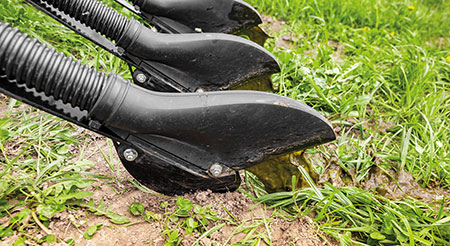
It has been specially designed for rugged terrains. With 25cm row spacing and optimally distanced trailing shoes (30 or 36, depending on the model), the TSB1 ensures uniform slurry application, even on uneven terrain, Pichon continues.
Thanks to a wear indicator, the operator is alerted when the central part needs to be replaced – a quick operation that takes just one minute. This mechanism ensures constant ground pressure throughout the part’s service life, enabling uniform fertiliser application.
As standard, the anti-drip system (ADS) prevents unwanted slurry leaks on roads when exiting fields. The boom also features a simple hydraulic folding mechanism, forming a compact triangle for easy road transport and optimal visibility for the driver.
The TSB1 boom also reduces ammonia emissions through improved infiltration of nutrients into the soil and reduction in odours. It has a transport width of less than 3m.
Visit the Pichon website for more information
View FarmAds muck and slurry equipment for sale


